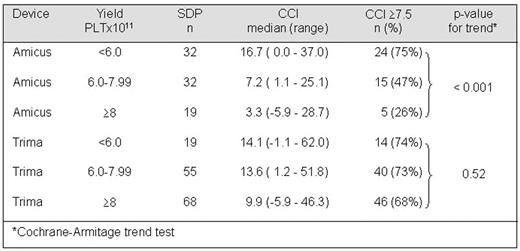Abstract
Because of an increasing requirement of single-donor apheresis platelets (SDP) and concomitantly a limited number of platelet (PLT) donors, it is necessary to optimize the productivity of plateletpheresis. One possibility is to increase its yield, targeting 3–4 SDP from one donation. However, no data demonstrate the transfusion effectiveness of these high-yield SDP. In a prospective study in pediatric patients we investigated the effect of plateletpheresis yield on transfusion effectiveness of 225 leukocyte-depleted SDP produced on two different apheresis devices: Amicus Crescendo (Baxter) (n=83), and Trima Accel (Gambro BCT) (n=142). The SDP were transfused to 30 children (17 girls and 13 boys, age up to 18 y) with thrombocytopenia due to chemotherapy or aplastic anemia (median, 7/child, range, 1–52). Exclusion criteria were: splenomegaly, fever, major hemorrhage or transfusion reaction. The transfusion effectiveness, measured by the 1-hour corrected count increment (CCI = increase in PLT count [109/l] x body surface area [m2] / number of PLT given [1011]), was considered as satisfactory if CCI ≥7.5. The median PLT yield was 6.6x1011 (range, 2.6–10.0) with Amicus and 7.9x1011 (1.8–11.5) with Trima. The CCI was ≥ 7.5 in 44/83 (53%) SDP produced with Amicus and in 100/142 (70%) produced with Trima. Results are summarized in the table. Univariate linear mixed effect (LME) analysis revealed that apheresis on the Amicus (p<0.001), need for parenteral calcium application during apheresis (p=0.001), higher PLT concentration in the product (p=0.002), higher apheresis yield (p=0.004), longer delay from apheresis to transfusion (p=0.023), older patient’s age (p<0.001), and a higher number of previous transfusions (p=0.031) were significantly associated with lower CCI. Multivariate LME analysis accounting for the remaining factors demonstrated that a higher apheresis yield led to lower CCI of SDP produced with Amicus (coefficient, −1.93; p=0.037), but not with Trima (−0.06, p=0.90). Looking for explanatory pathophysiological mechanisms, expression of p-selectin on PLTs and pH were measured prospectively in 43 and 22 SDP, respectively. Both lower pH (p=0.024) and higher expression of p-selectin (p=0.001) were significantly associated with lower CCI. High PLT yields showed a tendency for higher p-selectin expression (p=0.084), but no influence on pH (p=0.99).We conclude that at least in the Amicus device higher PLT yields per donation were associated with lower CCI in transfused patients. We recommend that target PLT yield per donation produced with Amicus should not exceed 6.0x1011.
At this time, possible explanations for our observations are speculative. In Amicus, PLTs are concentrated in the centrifuge during the whole apheresis, whereas in Trima they are directly collected in the storage bag. PLTs harvested by Amicus are stored in 65% T-sol and 35% donor plasma, whereas PLTs from Trima are stored in undiluted donor plasma. Further studies with different devices are required to measure the effect of plateletpheresis yields on transfusion effectiveness of SDP.
Author notes
Corresponding author


This feature is available to Subscribers Only
Sign In or Create an Account Close Modal